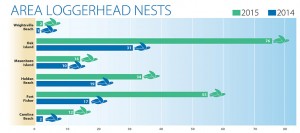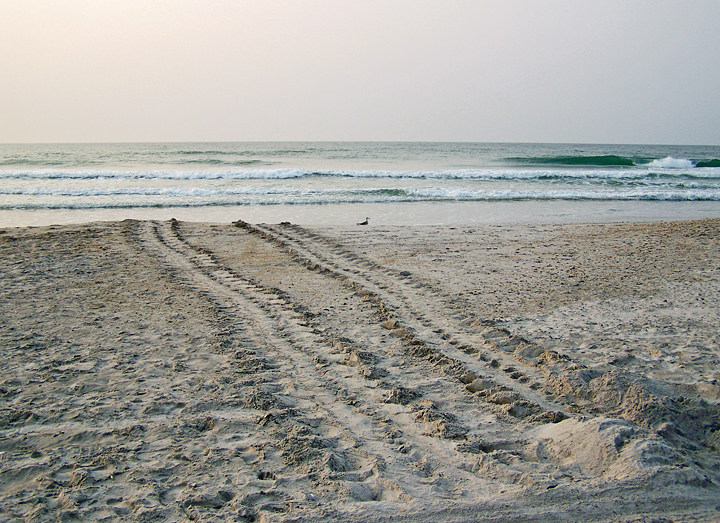Turtle enthusiasts statewide are clicking their heels — or their flippers — as the 2015 sea turtle nesting season, now about halfway over, is off to a successful start. The number of nests laid by the Caretta caretta, more commonly known as the loggerhead sea turtle, in eastern North Carolina has increased significantly over 2014.
“On a state level, the turtles are very actively nesting this summer — certainly more than last summer,” said Nancy Fahey, coordinator of the Wrightsville Beach Sea Turtle Project.
Some communities, like Fort Fisher, have tripled their sea turtle nest count over last year.
In 2014, Wrightsville Beach had one loggerhead nest. This year, there are two thus far.
“[The number of nests] varies from year to year,” Fahey explained. “We had eight nests in 2013. … It’s disappointing that we only have two nests. That’s not many to account for the second month into turtle season.”
Fahey explained because sea turtles nest approximately every four years, rather than annually, nesting periods have highs and lows.
“2014 was an off year. It is cyclical,” she said. “They were not nesting in as high of numbers, so we were expecting to see fewer nests. Also, they were renourishing our beach last summer and they worked into mid-June, which I think we all know is likely a deterrent to the nesting turtles because of the alteration of the natural habitat.”
Each summer from May 15-Aug. 31, Fahey heads up a team of volunteers that monitors the beach every morning at sunrise for signs of sea turtle nesting activity.

“The volunteers have been awesome,” she said. “They’ve worked diligently to find the crawls. They’ve been so conscientious looking out for tracks and by making sure they call me if they see anything that they interpret as a disturbance or a crawl, so that’s all we can do,” she said.
Patrick Amico, a park ranger at Fort Fisher State Recreation Area, and his colleagues have also been carefully monitoring the area’s 55 loggerhead nests.
“Every morning, we drive the beach early in the morning and we look for tracks. We identify turtle activity as either a false crawl [a turtle that crawls out of the ocean and back in without laying a nest], or a nest. We document it either way. If it is a nest, we mark the area. We take GPS points. We do some data work. We take an egg for a DNA study everyone else in the state is participating in and then we cage the nest. We put up a little sign that says ‘do not disturb,’” he said. “On day 50, we’ll put out a runway for the nest, which is just silk cloth. … That kind of aids them down the beach. The hatching window is 50-80 days, but 60 is the average.”
Amico said volunteers help the park rangers monitor nests.
“Around day 50, volunteers will sit with the nest,” he said. “Their goal is to keep the runway smooth and clean. They’re hoping to be there when the nest hatches.”
Amico doesn’t have any guesses as to why the loggerhead nest count has increased dramatically since last year.
“If you look at sea turtle statistics for 2014, it was a record low year across the state, so our drop just coincided with the drop every beach in North Carolina saw last year. There’s a natural cycle — a few good years and then a bad year,” he said. “We think we’re just back on that upswing and all the other beaches are seeing the same thing.”
Amico said the beach’s calm atmosphere is ideal for nesting turtles.
“We don’t have any human interference down here,” he said. “There’s no beach renourishment and there’s no construction or anything like that — limited development.”
Amico hopes to see even more nests at Fort Fisher this season.
“It’s early July. We can see quite a few more nests this year,” he said.
Jaymie Reneker, a Master of Science candidate studying sea turtles at the University of North Carolina Wilmington, has advice for beachgoers during turtle nesting season.
“If you do encounter a turtle if you’re out on the beach, the best thing to do is to stand back. Stand behind it and stay out of its line of sight. Stay out of the turtle’s way and let it do what it’s supposed to do,” she said.
Reneker also said white lights can distract nesting and hatching turtles.
“They are very aware of white lights, so one thing you can do is put red cellophane over your flashlights. …They don’t see as well in the red spectrum,” she said. “Most beaches are pretty quiet in the middle of the night, so turtles will come up and the temperature might not be right for them or the sand composition feels a little weird and they decide to go back to the water, but some turtles are scared off by humans if they see white lights on the beach or something startles them or there are obstacles on the beach that cause them to turn around.”
For an up-to-date total count of the number of sea turtle nests reported in the state of North Carolina, visit www.seaturtle.org/groups/ncwrc/
email [email protected]




